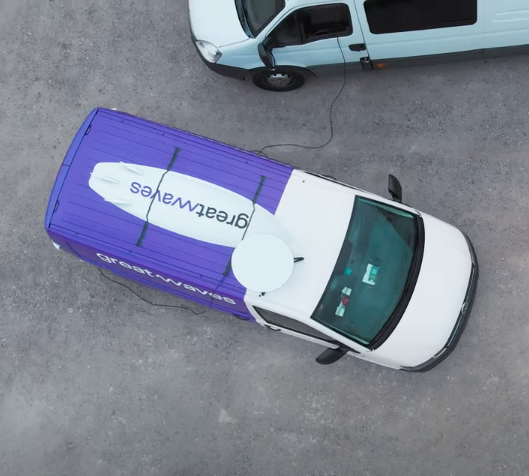Improving connectivity for humanitarian staff in refugee and displaced settings
Reliable connectivity is essential for humanitarian staff to do their work in displaced settings. With Greatwaves we look for a solution.


Connectivity in refugee and displacement settings is often unreliable. This causes issues for both refugees and humanitarian staff working in those areas. Humanitarian staff in these settings are often on the go, working from their vehicles. These are their offices and means of transport to reach their beneficiaries. But a moving office doesn’t automatically have everything needed to work. You can make a makeshift desk, but what do you do if you need an internet connection that is reliable and realistic?
This scenario got us thinking – What if we could help develop a solution that is cheap, durable, easy to install, and could help both refugees and humanitarian workers on the go to connect to the internet? What if we could improve in-vehicle internet and create an easy way to track these vehicles using GPS data? High end commercial solutions doing this already exist, but are often way too expensive for humanitarians working on tight budgets. We wanted to solve both of these questions – and split it into two parts, the first being focused on in-vehicle internet and tracking.
Part two of our solution is to find a way to turn these vehicles into mobile wifi hotspots for the beneficiaries to use once the vehicles reach their areas and are stationary. For that satellite internet could be the best solution out there, of which you can read more about here.
We decided to work with Greatwaves on the first part of our solution. Below Wouter from Greatwaves and Jos from 48percent.org explain how we worked together to create a prototype for a mobile wifi-hotspot.
What drew Greatwaves to this project?
“At Greatwaves we love making the internet and wifi amazing. We use the most awesome hardware we can find and help companies that truly rely on great internet connectivity. We wanted to do something good with the knowledge and skills that we have available. Entrepreneurship is not only about reaping the benefits of your work but also on giving back to communities that could really benefit from our team’s knowledge. I believe that if everyone in the world has access to the internet then it would unlock a world of opportunities for so many people. How cool is it to be able to work on that? This project really challenged us because we had to find the absolute most reliable hardware for tough environments, while still using a shoestring budget. It also challenged us to think beyond out usual scope and come up with a viable business model.” (Wouter)
Collaborating on a solution
Wouter: “We started out by sourcing the cheapest hardware that we could find that could reliably provide their fleet of Toyota Land Cruisers with mobile wifi, while also including a GPS antenna for the vehicle tracking. We arrived at a brand that’s very well known to us: Mikrotik. Our total hardware cost per vehicle ended up being €62. That’s about 10% of what commercial systems would cost and it’s fully sand, sahara & tamper-proof. We tested and configured the hardware side of things and actually fitted out one of our company vans with the same system. It works great!”
Jos (48percent.org): “We took the hardware solution Greatwaves came up with and built a web application around it that can be used to track the device and the car. This allows humanitarian organizations to keep track of their staff, see where cars are and whether they have been stationary at a certain location. Greatwaves already had a script running on the Mikrotik router that they chose for this project. We adapted that a little bit because we needed an identifier from the router instead of just GPS coordinates. We used the script to talk to our web application which we built in Python/Django.”
One of the challenges we faced was how to set the system up in a reproducible way without creating a technical block for the users of the platform. An example being that the user has to set up their own api keys for the maps. Creating interactive maps brings its own challenges that we don’t run into in our day to day work.
This is what the map looked like from when we tested it in Groningen
“Hopefully this setup will be a great improvement! The quality of the internet will be much much better than the current setup using 4G USB-sticks. And it has the added value of being able to track vehicle assets using the software that 48percent.org developed.” (Wouter)
Do you want to try it for yourself?
It is possible to set this up for yourself, with some help. Before you can start installation, you need to come up with a domain name and let us know. We will send you a preconfigured Mikrotik. All you have to do is personalize the domain name and add a working sim card. Once you have received the Mikrotik, you can start connecting the pre-installed device in your car and position the GPS antenna. This is necessary to receive a strong signal. Afterwards the application is set up. This can be deployed as a Docker image in a public or private cloud. The application needs ingress on the domain name and needs to be configured with a map key. An administration password is required to access the configuration panel. The database will be provisioned by the application and does not require any additional work to set up.
After the above steps have been properly installed and configured, you turn on your ‘car’ by turning on the Mikrotik. Within a couple of minutes, the GPS antenna should get a fix and the Mikrotik will post this to the application. When logging in to the admin panel accessed earlier, the car will appear as a MAC address in the database. You can then attach the license plate number as an easy identifier. You will now be able to do test drives to check that everything works correctly. The map function explained earlier shows the car driving around. If you want to try this for yourself, or if these instructions are too technical, please contact 48percent.org. We can get you started.
What is next for our project?
We need a partner to test our solution in the field, preferably in a humanitarian setting. We are looking for partners willing to test the solution in a couple of vehicles. They will drive around with them for a while to see whether it truly works and helps. If the in-vehicle solution works, we can move to part two to test whether satellite options on these vehicles will work.
If you are interested in partnering with us, please let us know through hello@48percent.org.